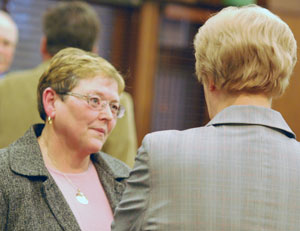Ann Arbor Downtown Development Authority board meeting (Jan. 9, 2013): The first meeting of the year for the DDA’s board featured a packed agenda – with items ranging from budget adjustments to the adoption of recommendations on the Connecting William Street project. Also voted on by the board were grants to the nonprofit Dawn Farm, an allocation of funds for the DDA’s energy grant program, and two monthly parking permits for The Varsity residential development.

Jeff Speck’s “Walkable City” was a volume brought to the Jan. 9, 2013 Ann Arbor Downtown Development Authority board meeting by local developer Peter Allen. (Photos by the writer.)
The budget adjustments to FY 2013 were made in order to account for roughly $2.6 million in construction costs associated with the Library Lane underground parking garage. They had been allocated in the previous year’s budget, but not paid last year – because the completion of the construction extended into this fiscal year.
The FY 2012 audit report, which the board also approved at its Jan. 9 meeting, shows that for FY 2012, the DDA spent about $2.5 million less than anticipated for that year – because the construction invoices were not all submitted to the DDA by the time books closed for the year.
The result of those changes leaves a budget with $22,237,924 in revenues against $26,339,555 in expenses for the year – which translates to a planned use of the DDA’s fund balance reserve of $4,101,632. That’s about half of the existing fund balance.
Not a part of the revised budget was the approval of two allocations made by the board – one of $50,000 in connection with the DDA’s existing energy grant program, and another of $150,000 for a grant to Dawn Farm, a nonprofit offering both residential and out-patient services supporting recovery for alcoholics and drug addicts. The energy allocation will essentially attempt to leverage energy audits completed through the DDA’s program for use in the Michigan Saves program, which offers low-interest financing for energy improvements.
The board also approved recommendations to be forwarded to the city council on the future redevelopment of five city-owned sites currently used for parking. The project, which is now named Connecting William Street (CWS), began with an April 4, 2011 city council resolution that directed the DDA to seek “robust public input” from experts, stakeholders and residents to develop a plan for those parcels.
In connection with the parcels in that area, the board also adopted a policy on possible grants from the DDA’s tax increment finance (TIF) funds to support development of the CWS properties. The policy makes clear that the DDA would not forgo its TIF capture on any property – but the amount of the grant would be calculated based on TIF revenue.
Also in connection with the CWS project, the board heard remarks during public commentary from representatives of the city’s park advisory commission as well as the State Street Area Association. The board also invited Doug Kelbaugh, a University of Michigan professor of architecture and urban planning, to share his thoughts on parks versus plazas – and why he thinks the site on top of the Library Lane parking garage is more likely to succeed as a plaza instead of a park. [Full Story]






